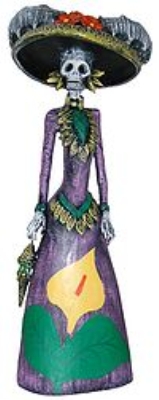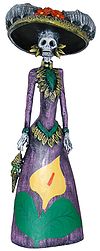
Calaca
Encyclopedia
- For the municipality in the Philippines, see Calaca, BatangasCalaca, BatangasCalaca is a 1st class municipality in the Province of Batangas, Philippines. According to the latest census, it has a population of 64,966 people in 11,306 households.The mayor of this municipality is Sofronio "Nas" C...

Mexican Spanish
Mexican Spanish is a version of the Spanish language, as spoken in Mexico and in various places of Canada and the United States of America, where there are communities of Mexican origin....
name for skeleton
Skeleton
The skeleton is the body part that forms the supporting structure of an organism. There are two different skeletal types: the exoskeleton, which is the stable outer shell of an organism, and the endoskeleton, which forms the support structure inside the body.In a figurative sense, skeleton can...
) is a figure of a skull
Human skull
The human skull is a bony structure, skeleton, that is in the human head and which supports the structures of the face and forms a cavity for the brain.In humans, the adult skull is normally made up of 22 bones...
or skeleton (usually human) commonly used for decoration during the Mexican
Mexico
The United Mexican States , commonly known as Mexico , is a federal constitutional republic in North America. It is bordered on the north by the United States; on the south and west by the Pacific Ocean; on the southeast by Guatemala, Belize, and the Caribbean Sea; and on the east by the Gulf of...
Day of the Dead
Day of the Dead
Day of the Dead is a Mexican holiday celebrated throughout Mexico and around the world in many cultures. The holiday focuses on gatherings of family and friends to pray for and remember friends and family members who have died. It is particularly celebrated in Mexico, where it attains the quality...
festival, although they are made all year round. Tracing their origins from Aztec
Aztec
The Aztec people were certain ethnic groups of central Mexico, particularly those groups who spoke the Nahuatl language and who dominated large parts of Mesoamerica in the 14th, 15th and 16th centuries, a period referred to as the late post-classic period in Mesoamerican chronology.Aztec is the...
imagery, calacas are frequently shown with marigold
Tagetes
Tagetes is a genus of 56 species of annual and perennial mostly herbaceous plants in the sunflower family . The genus is native to North and South America, but some species have become naturalized around the world. One species, T...
flowers and foliage. As with other aspects of the Day of the Dead festival, calacas are generally depicted as joyous rather than mournful figures. They are often shown wearing festive clothing, dancing, and playing musical instruments to indicate a happy afterlife. This draws on the Mexican belief that no dead soul likes to be thought of sadly, and that death should be a joyous occasion. This goes back to Aztec beliefs, one of the few traditions to remain after the Spanish conquest.
Calacas used in the festival include carved skull masks worn by revelers, small figures made out of carved wood or fired clay, and sweet treats in the form of skull
Human skull
The human skull is a bony structure, skeleton, that is in the human head and which supports the structures of the face and forms a cavity for the brain.In humans, the adult skull is normally made up of 22 bones...
s or skeletons. Calacas are sometimes made of wood, stone, or even candy.
A popular phrase among Mexicans and those Latinos that personally know some is "se lo (la) llevo la calaca" after someone has died, literally meaning "the Calaca took him (her)" or "death took him (her)".
In Guatemala, "calaca" is understood as "death". The figure of a bare skeleton represents death and implies fear of death. Thus, it is not depicted as a joyful image.
Calaca-like figures can be seen in the Tim Burton
Tim Burton
Timothy William "Tim" Burton is an American film director, film producer, writer and artist. He is famous for dark, quirky-themed movies such as Beetlejuice, Edward Scissorhands, The Nightmare Before Christmas, Ed Wood, Sleepy Hollow, Corpse Bride and Sweeney Todd: The Demon Barber of Fleet...
films The Nightmare Before Christmas
The Nightmare Before Christmas
The Nightmare Before Christmas, often promoted as Tim Burton's The Nightmare Before Christmas, is a 1993 stop motion musical fantasy film directed by Henry Selick and produced/co-written by Tim Burton. It tells the story of Jack Skellington, a being from "Halloween Town" who opens a portal to...
and Corpse Bride
Corpse Bride
Corpse Bride, often promoted as Tim Burton's Corpse Bride, is a 2005 stop-motion-animated fantasy musical film directed by Mike Johnson and Tim Burton. It is set in a fictional Victorian era village in Europe. Johnny Depp led an all-star cast as the voice of Victor, while Helena Bonham Carter ...
, the 2008 PlayStation 3 game LittleBigPlanet
LittleBigPlanet
LittleBigPlanet, commonly abbreviated LBP, is a puzzle platformer video game, based on user-generated content, for the PlayStation 3 first announced on 7 March 2007, by Phil Harrison at the Game Developers Conference in San Francisco, California...
, and the 1998 Tim Schafer
Tim Schafer
Timothy Schafer is an American computer game designer. He founded Double Fine Productions in January 2000, after having spent over a decade at LucasArts...
computer game Grim Fandango
Grim Fandango
Grim Fandango is a personal computer game in the graphic adventure genre released by LucasArts in 1998 and primarily written by Tim Schafer. It is the first adventure game by LucasArts to use 3D computer graphics overlaid on pre-rendered, static backgrounds...
.
See also
- CalaveraCalaveraThe word calavera, Spanish for "skull", can refer to a number of cultural phenomena associated with the Mexican celebration of the Day of the Dead and the Roman Catholic holiday All Souls Day....
- CucoCucoThe Coco is a mythical ghost-monster; equivalent to the boogeyman, found in many Hispanic and Lusophone countries. He can also be considered a Hispanic version of a bugbear, as it is a commonly used figure of speech representing an irrational or exaggerated fear...
- La Calavera Catrina

